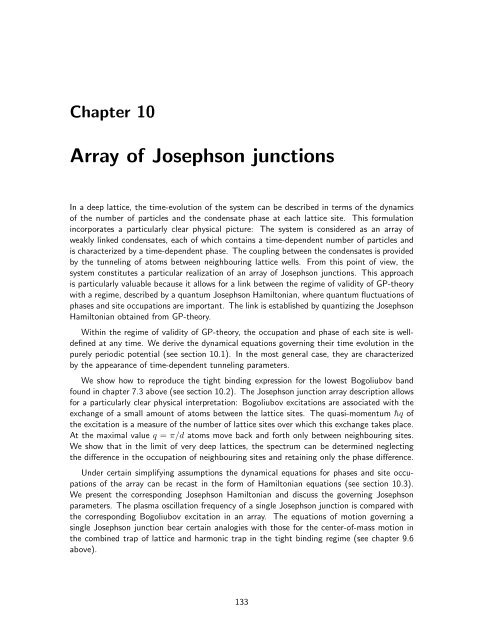Bose-Einstein Condensates in Rotating Traps and Optical ... - BEC
Bose-Einstein Condensates in Rotating Traps and Optical ... - BEC
Bose-Einstein Condensates in Rotating Traps and Optical ... - BEC
Create successful ePaper yourself
Turn your PDF publications into a flip-book with our unique Google optimized e-Paper software.
Chapter 10<br />
Array of Josephson junctions<br />
In a deep lattice, the time-evolution of the system can be described <strong>in</strong> terms of the dynamics<br />
of the number of particles <strong>and</strong> the condensate phase at each lattice site. This formulation<br />
<strong>in</strong>corporates a particularly clear physical picture: The system is considered as an array of<br />
weakly l<strong>in</strong>ked condensates, each of which conta<strong>in</strong>s a time-dependent number of particles <strong>and</strong><br />
is characterized by a time-dependent phase. The coupl<strong>in</strong>g between the condensates is provided<br />
by the tunnel<strong>in</strong>g of atoms between neighbour<strong>in</strong>g lattice wells. From this po<strong>in</strong>t of view, the<br />
system constitutes a particular realization of an array of Josephson junctions. This approach<br />
is particularly valuable because it allows for a l<strong>in</strong>k between the regime of validity of GP-theory<br />
with a regime, described by a quantum Josephson Hamiltonian, where quantum fluctuations of<br />
phases <strong>and</strong> site occupations are important. The l<strong>in</strong>k is established by quantiz<strong>in</strong>g the Josephson<br />
Hamiltonian obta<strong>in</strong>ed from GP-theory.<br />
With<strong>in</strong> the regime of validity of GP-theory, the occupation <strong>and</strong> phase of each site is welldef<strong>in</strong>ed<br />
at any time. We derive the dynamical equations govern<strong>in</strong>g their time evolution <strong>in</strong> the<br />
purely periodic potential (see section 10.1). In the most general case, they are characterized<br />
by the appearance of time-dependent tunnel<strong>in</strong>g parameters.<br />
We show how to reproduce the tight b<strong>in</strong>d<strong>in</strong>g expression for the lowest Bogoliubov b<strong>and</strong><br />
found <strong>in</strong> chapter 7.3 above (see section 10.2). The Josephson junction array description allows<br />
for a particularly clear physical <strong>in</strong>terpretation: Bogoliubov excitations are associated with the<br />
exchange of a small amount of atoms between the lattice sites. The quasi-momentum ¯hq of<br />
the excitation is a measure of the number of lattice sites over which this exchange takes place.<br />
At the maximal value q = π/d atoms move back <strong>and</strong> forth only between neighbour<strong>in</strong>g sites.<br />
We show that <strong>in</strong> the limit of very deep lattices, the spectrum can be determ<strong>in</strong>ed neglect<strong>in</strong>g<br />
the difference <strong>in</strong> the occupation of neighbour<strong>in</strong>g sites <strong>and</strong> reta<strong>in</strong><strong>in</strong>g only the phase difference.<br />
Under certa<strong>in</strong> simplify<strong>in</strong>g assumptions the dynamical equations for phases <strong>and</strong> site occupations<br />
of the array can be recast <strong>in</strong> the form of Hamiltonian equations (see section 10.3).<br />
We present the correspond<strong>in</strong>g Josephson Hamiltonian <strong>and</strong> discuss the govern<strong>in</strong>g Josephson<br />
parameters. The plasma oscillation frequency of a s<strong>in</strong>gle Josephson junction is compared with<br />
the correspond<strong>in</strong>g Bogoliubov excitation <strong>in</strong> an array. The equations of motion govern<strong>in</strong>g a<br />
s<strong>in</strong>gle Josephson junction bear certa<strong>in</strong> analogies with those for the center-of-mass motion <strong>in</strong><br />
the comb<strong>in</strong>ed trap of lattice <strong>and</strong> harmonic trap <strong>in</strong> the tight b<strong>in</strong>d<strong>in</strong>g regime (see chapter 9.6<br />
above).<br />
133




